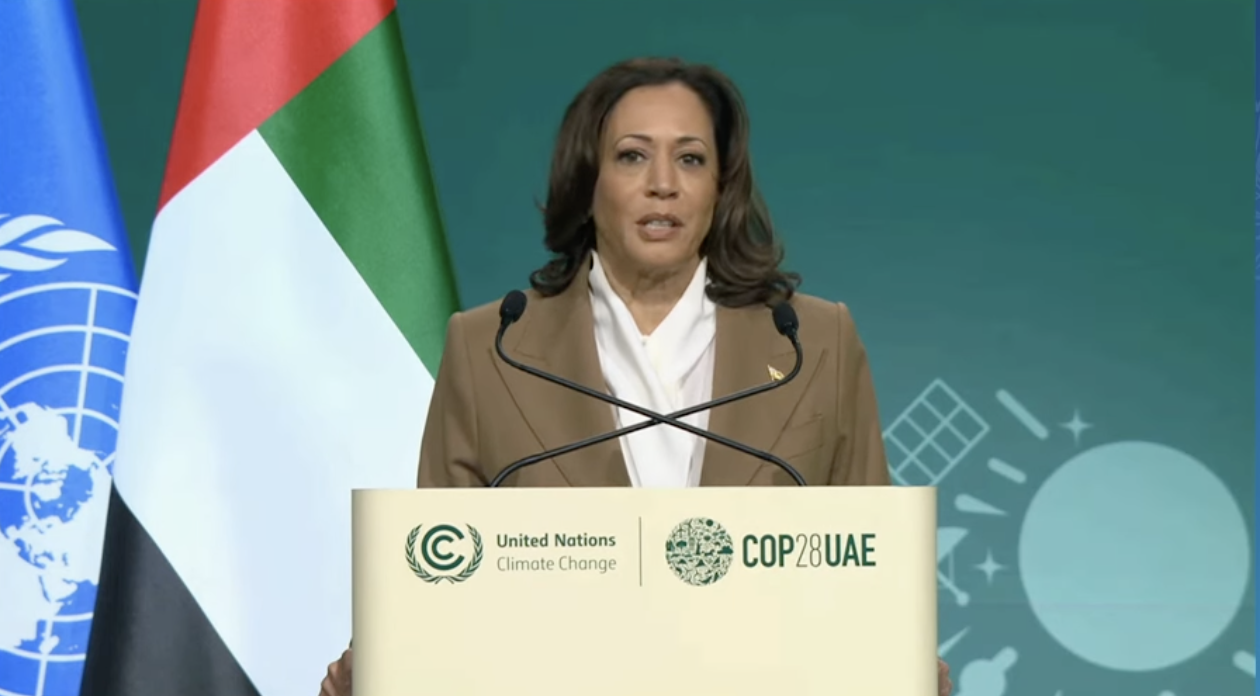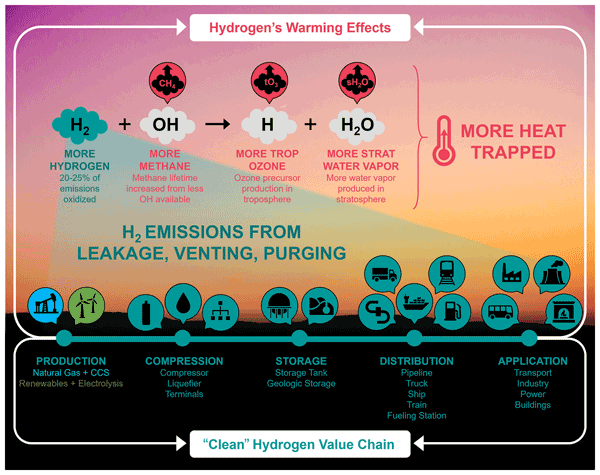In 1971, The New York Times Published The First Climate Denial Op-Ed
 The public mockery of “environmentalists” for concern about climate pollution began with a The New York Times op-ed by an Ayn Rand acolyte on August 28, 1971. Published with the headline “No, Breathe Easier,” mining executive and propagandist Eugene Guccione falsely claimed that “we are winning the war on pollution” and then called the greenhouse effect “idiocy”.
The public mockery of “environmentalists” for concern about climate pollution began with a The New York Times op-ed by an Ayn Rand acolyte on August 28, 1971. Published with the headline “No, Breathe Easier,” mining executive and propagandist Eugene Guccione falsely claimed that “we are winning the war on pollution” and then called the greenhouse effect “idiocy”.
Unaware that particulate concentration is decreasing, “environmentalists” talk about the New Ice Age Theory. The build‐up of dust in the air, so goes the argument, will screen out the sun and we’ll all be turned into ice.Then there is the Greenhouse Effect Theory. The build‐up of carbon dioxide in the atmosphere, so goes this particular idiocy, will cause a temperature increase throughout the planet … and we’ll drown in the tidal wave resulting from the melting of the polar ice caps, or roast to death.
These so‐called theories contradict each other. We cannot both freeze and roast at the same time. It’s either or. But relax. It’s neither. We won’t freeze because there is no such thing as a build‐up of particulates in the air, as lots of tests indicate. Nor will we roast because at the present level of carbon dioxide in the atmosphere it would take about 957 years to triple the current level. Such speculations have no more scientific validity than the prediction that my puppy dog, at his present growth rate, would be fifteen feet long and weigh 900 pounds at age five.
The next week, the Times published a response from climate scientist Stephen Schneider, noting Guccione’s op-ed was both factually wrong and dangerously optimistic about the threat of pollution-induced climate change.
Guccione, a chemical engineer who embraced the ideology of free-market economists such as Friedrich Hayek and Alan Greenspan, was then the editor of Engineering & Mining Journal. He later edited Mining Engineering journal and chaired the Mountain States Lime cement plant in Utah as well as the free-market Committee for Monetary Research and Education. He continued to rail against environmental legislation for impeding the coal and oil industries, argued for subsidizing the domestic oil industry to compete with the Soviet Union, and fulminated against taxation as a form of mugging.
By the 1980s, the Times was running regular climate-denial advertorials from Mobil (and after a merger, ExxonMobil) on its op-ed pages into the 2000s. The tradition continued in the Internet age with dynamic greenwashing Web campaigns co-developed by the Times and ExxonMobil.
Full text of the Guccione op-ed:
Nearly 500 Fort Myers Residents Trapped in Milton's Path: "Inmates will be evacuated to top floors in case of flooding."

Lee County Jail lies about 1500 feet from the water’s edge in Evacuation Zone A
Nearly 500 Floridians are trapped in Milton’s path as it nears landfall tonight. Fort Myers’ Lee County Jail is 1500 feet from the tidal estuary of the Caloosahatchee River. The jail, a hulking, near windowless facility with 457 beds that serves as the main booking facility for the county, lies in Lee County’s Hurricane Evacuation Zone A. The county ordered all free people in Evacuation Zones A and B to flee by Tuesday evening, but Lee County Sheriff Carmine Marceno decided not to evacuate the 477 inmates in the overstuffed jail to safety.
The National Weather Service is warning that as Hurricane Milton makes landfall tonight, it will push the Gulf of Mexico waters past Cape Coral and into the Caloosahatchee, with tropical-storm-force winds bringing a storm surge of up to 6 feet of water into the estuary.
The Lee County Sheriff’s office confirmed to Hill Heat this morning that there are no plans to evacuate the facility.
“Inmates will be evacuated to top floors in case of flooding,” public information officer Julie Martin told Hill Heat, and the “kitchen is staffed and has two weeks of food for inmates and staff.”
There are contingency plans to evacuate the inmates to Lee County’s Core facility farther inland, Martin stated. The core facility currently has 1169 inmates and 47 spare beds.
Lee County Sheriff spokesman Nestor Montoya told the Fort Myers News-Press that all inmates are “safe”.
Lee County Jail is one of several carceral facilities in Florida not being evacuated from the fossil-fueled Milton.
Update October 10: The Lee County Sheriff’s Office reports that there is power and running water at the jail, with no flooding from Hurricane Milton.
Harris Campaign: Trump Will Sell America Out to Oil Barons

Vice President Kamala Harris at the COP 28 climate talks, 2023.
At her Tuesday campaign rally in Wisconsin, Vice President Kamala Harris said that Trump “literally promised Big Oil companies and Big Oil lobbyists he would do their bidding for $1 billion in campaign donations.”
The Harris for President campaign issued the following press release today.
The Wall Street Journal reported today that a “megawealthy coterie of oil tycoons” are “banking on promises” from Donald Trump to deliver his dangerous Project 2025 agenda that is even “more stridently pro-fossil fuel than Trump’s first administration.”
Trump already offered control of White House policy to oil barons while asking for $1 billion to his campaign.
These Big Oil donations solicited by Trump are being investigated as a “blatant quid pro quo” by Senate investigators and “make the magnates among some of Trump’s biggest donors and represent an increase from past election cycles.”
Trump promised to issue “immediate approvals” for Big Oil’s dangerous schemes while asking them to put him back in the White House.
Oil lobbyists are already drafting ready-made executive orders for Trump to sign to give them tax handouts, increase costs on Americans, and pollute our environment.
Trump has even said that he would cut “environmental agencies” and the Department of Interior, which are critical to protecting public lands and ensuring clean air and water for all Americans.
Harris for President spokesperson Joseph Costello released the following statement:
“Oil barons are salivating because climate denier Donald Trump promised to do their bidding while asking them to bankroll his run for the presidency. Trump’s promises to Big Oil would sacrifice good paying jobs that are driving an American energy and manufacturing boom, and instead give billion dollar handouts to corporations at the expense of working families and a healthy future for our children.
“Under the Biden-Harris administration, America is more energy independent than ever. Vice President Harris cast the tie breaking vote on the Inflation Reduction Act, creating hundreds of thousands of good paying energy jobs and making the biggest climate investment in world history. But Trump promises to dismantle all this progress and sell out America’s future for his own personal gain.”
Scientific Leaders: "No Anthropocene" Vote Was a Sham
 Readers of the New York Times opened their papers today to a giant photo of Donald Trump appearing above the headline “Geologists Say It’s Not Time to Declare a Human-Created Epoch”. (The photo of Trump was attached to a different story.) The article, written by reporter Raymond Zhong (who has been on the climate beat for two and a half years), appeared online yesterday with the headline “Are We in the ‘Anthropocene,’ the Human Age? Nope, Scientists Say.”
Readers of the New York Times opened their papers today to a giant photo of Donald Trump appearing above the headline “Geologists Say It’s Not Time to Declare a Human-Created Epoch”. (The photo of Trump was attached to a different story.) The article, written by reporter Raymond Zhong (who has been on the climate beat for two and a half years), appeared online yesterday with the headline “Are We in the ‘Anthropocene,’ the Human Age? Nope, Scientists Say.”
“A panel of experts voted down a proposal to officially declare the start of a new interval of geologic time, one defined by humanity’s changes to the planet,” the article summarizes. Zhong quotes panel members Aarhus University geologist Jan A. Piotrowski and University of Wales Trinity Saint David stratigrapher Mike Walker, who voted against the proposal.
The chair and second vice-chair of the panel in question, the Subcommission on Quaternary Stratigraphy (SQS) of the International Commission on Stratigraphy (ICS) within the International Union of Geological Sciences (IUGS), have now forcefully announced the vote was a sham and should be considered “null and void”.
In brief, the alleged voting and the process surrounding it is open to challenge based on the grave violation of the ICS Statutes and thus must be considered null and void.
They report that the improper vote was instigated by Peking University geologist Liping Zhou, first vice-chair of the panel, and University of Florence paleoclimatologist Adele Bertini, secretary, despite opposition from the chair, University of Leicester geologist Jan Zalasiewicz, and second vice-chair Martin J. Head, a stratigrapher at Brock University.
Zalasiewicz and Head note that “a large majority of SQS members who took part in the alleged voting” (11 out of 16) were “not eligible as voting members at the time they cast their votes,” as they had been members of the subcommission for more than 12 years. The five eligible members do not represent a needed quorum for a vote to take place.
Moreover, the sham vote was held even as a Geoethics Commission report on the workings of the subcommission’s Anthropocene Working Group (AWG) was being reviewed by the president of the IUGS, geologist John Ludden. Zalasiewicz requested the report be distributed to the subcommission members before any vote was held, but Zhou and Bertini ignored him and pushed forward the sham vote, with members notifying the New York Times about the fraudulent result. Ludden released the report to the SQS and the AWG on March 5th, after the Times story was published. According to Zalasiewicz,
The findings of that report included: that the AWG, in preparing its proposal, was unfairly treated, via conflicts of interest, application of different standards than to other working groups, and unreasonable requests and restrictions, while insufficient time was allowed for comment on the proposal, and the AWG were not asked to provide feedback on the discussions as would be normal practice. The Geoethics Commission further observed that the process as a whole between AWG/SQS/ICS/IUGS was dysfunctional; it thus recommended the urgent suspension of any voting procedures (though not examining their validity).Panel member Naomi Oreskes, a historian of climate science, responds:
The irregularities in the SQS voting procedures strongly suggest that the SQS did not make its decision on scientific grounds. The argument put forward by the AWG—and overwhelmingly endorsed by the AWG membership—was never given a fair hearing.What’s particularly sad about this to me—as a person who cut my teeth in field geology—is that by rejecting the Anthropocene proposal, the SQS suggests to the world that they are unwilling or unable to recognize what we all can now see: that we do indeed live in the Anthropocene. By denying the obvious, the stratigraphers threaten to undermine the credibility of the science that they claim to be protecting.
The full text of the press statement from Profs. Zalasiewicz and Head and Zalasiewicz’s report to the subcommission, are below.
2023 Election Results
Governors
The incumbent governors in Kentucky and Mississippi were re-elected in Tuesday’s two gubernatorial elections. Kentucky’s Democratic governor Andy Beshear was re-elected, and used his acceptance speech to personally thank Hadley Duvall, a rape survivor who spoke out powerfully against the extreme position on abortion held by Beshear’s opponent. Beshear will now get another term to promote new manufacturing and EV jobs despite the legislature’s best efforts to prop up King Coal.
In Mississippi, Republican governor Tate Reeves defeated Democratic Public Service Commissioner Brandon Presley, whose campaign for Medicaid expansion and against Reeves’ corruption was not enough to overcome Mississippi’s strong Republican tilt.
Virginia
In Virginia, Democrats kept their majority in the state senate by a 21-19 margin, and flipped control of the House of Delegates, winning at least a 51-48 majority. (The Republican candidate is holding on to a slim lead in the race for HD 82, but that race has not been called.) The majority maker was Climate Cabinet-endorsed Michael Feggans in HD 97, where investments to protect Virginia Beach from flooding are an important issue. Joshua Cole, a Mountain Valley Pipeline opponent endorsed by both Climate Cabinet and Lead Locally, won his election for HD 65 around Fredericksburg. With Lead Locally’s support, activist Nadarius Clark was elected to represent the Suffolk-based HD 84.
Climate Cabinet also endorsed Russet Perry in her successful Loudon County race for SD 31, where she prevailed over a far-right son of a billionaire. For his leadership backing clean energy investments in a swing district centered around Newport News, Climate Cabinet had endorsed Democratic senator Monty Mason (D-SD 24). Mason was narrowly defeated by Danny Diggs, causing a net loss of one seat for Virginia Senate Democrats. Nevertheless, the June primary victories of Senators-elect Lachrese Aird, Jennifer Carrol Foy, and Saddam Azlan Salim, along with the retirement of Dominion Energy ally Dick Saslaw, will likely add up to a more progressive and unified Democratic caucus in the senate next year.
With these results, Virginia is likely to continue as the clean energy leader of the South. Democrats have dealt a serious blow to governor Glenn Youngkin’s plans to dismantle the climate progress made under his predecessor. In interviews with Inside Climate News, environmental leaders previewed their strategy for expanding rooftop solar and offshore wind even as Youngkin, who is described as “mostly hostile to climate policy,” remains in office for two more years. Inside Climate News notes:
One area where the Democrats now hold complete control is over the State Corporation Commission, or SCC, the regulatory body that oversees insurance, businesses, and—critically for the state’s climate goals—utilities. In Virginia, the dominant utilities are Dominion Energy and Appalachian Power Company.The SCC is meant to set utility rates that are fair for both consumers and companies. It also approves or denies the utilities’ decarbonization plans, which are needed to comply with emissions reductions mandated in the Clean Economy Act.
At the moment, the SCC is not fully operational. While two members are needed for the SCC to issue rulings, only one seat on the three-person board is filled. But SCC positions are legislative appointments, meaning with Democrats in the majority, they now control who will fill the two empty positions.
“The future of the SCC is in their hands,” said Shelby Green, a researcher at the Energy and Policy Institute, a watchdog group.
Hydrogen Hype's Physics Problem
 The Biden administration is spending billions on the National Clean Hydrogen Strategy, even recently celebrating Hydrogen Day on October 8 (because hydrogen’s atomic weight is 1.008) to “mark a symbolic opportunity to celebrate hydrogen—clean hydrogen, specifically—and the crucial role this element plays in supporting a robust, equitable clean energy future for all Americans.”
The Biden administration is spending billions on the National Clean Hydrogen Strategy, even recently celebrating Hydrogen Day on October 8 (because hydrogen’s atomic weight is 1.008) to “mark a symbolic opportunity to celebrate hydrogen—clean hydrogen, specifically—and the crucial role this element plays in supporting a robust, equitable clean energy future for all Americans.”
“There’s a lot to like about hydrogen as a fuel source, climate journalists such as David Gelles gush.
The only problem is that “clean hydrogen,” also known as “green hydrogen”—that is, hydrogen gas generated using renewable electricity—isn’t particularly “clean” or “green,” although it’s less polluting than “gray” and “blue” hydrogen, produced from natural gas.
Unfortunately, even “green” hydrogen is a powerful greenhouse pollutant.
As an important paper from Environmental Defense Fund scientists Ilissa Ocko and Steven Hamburg explains, hydrogen is unavoidably leaky, because it’s such a small molecule, and like methane, has a high short-term warming effect. In fact, one of hydrogen’s main warming effects is to increase the atmospheric lifetime of methane. Methane breaks down in contact with the hydroxyl (OH) radical formed when ultraviolet light interacts with ozone (O₃) and water vapor (H₂O). Hydroxyl also reacts with hydrogen molecules (H₂), so significant hydrogen pollution means atmospheric methane doesn’t break down. Thus, Ocko and Hamburg find:
Hydrogen’s 100-year greenhouse warming potential (GWP) is twice as high as previously thought, and its 20-year GWP is 3 times higher than its 100-year GWP. Hydrogen’s maximum GWP occurs around 7 years after the initial pulse of emissions, with a range of 25 to 60 based on uncertainties, and a central estimate of 40.
In short, “green” hydrogen isn’t.
Scientific American 1856: Scientific Ladies - Experiments with Condensed Gases.
 From Scientific American, Volume XII, Issue 1, published September 13, 1856.
From Scientific American, Volume XII, Issue 1, published September 13, 1856.

Scientific Ladies - Experiments with Condensed Gases.
Some have not only entertained, but expressed the mean idea, that women do not possess the strength of mind necessary for scientific investigation. Owing to the nature of woman’s duties, few of them have had the leisure or the opportunities to pursue science experimentally, but those of them who have had the taste and the opportunity to do so, have shown as much power and ability to investigate and observe correctly as men.
We have Miss Mitchell, who has been awarded the King of Denmark’s prize medal for her discoveries in astronomy; and there is Mrs. Somerville, of London, whose work on physical geography is one of the finest contributions to physical science ever published. So highly gifted is this lady, and so profoundly versed in the science, that the late Prof. Caldwell, of Louisville, who had an opportunity of conversing with her, and also seeing her perform some experiments, declared “she was deeply acquainted with almost every branch of physical science.” Other cases might be mentioned, but these are sufficient for our purpose.
Our constant readers will remember that several articles from different persons appeared in the last volume of the SCIENTIFIC AMERICAN, relating to solar heat at the surface of the earth. The question was introduced by Wm. Partridge, of Binghamton, who took the position, that density of the atmosphere, and not the angularity of the sun’s rays, was the principal reason why it was warmer in valleys than on the tops of mountains. His views were opposed by other correspondents, but none of them supported their opinions with practical experiments to decide the question; this we are happy to say has been done by a lady.
A paper was read before the late meeting of the Scientific Association, by Prof. Henry for Mrs. Eunice Foot (sic), detailing her experiments to determine the effects of the sun’s rays on different gases. These were made with an air pump and two glass receivers of the same size—four inches in diameter, and thirty in length. The air was exhausted from one and condensed in the other, and they were both placed in the sun light, side by side, with a thermometer in each. In a short period of time, the temperature in the receiver containing the condensed air, rose thirty degrees higher than the other ; thus proving conclusively that the greater density of air on low levels is at least one cause of greater heat in valleys than on mountains. Experiments were also tried with moist air, and its temperature was elevated above dry air. Hydrogen gas was placed in one receiver and oxygen in the other, when the temperature of the former rose to 104°, but the latter to 106° Fah.; while, in carbonic acid—a more dense gas than either—it rose to 126°.
It is believed and taught by geologists that during the period preceding the carboniferous era,—when the coal bed materials were forming—that the atmosphere of the earth contained immense quantities of carbonic acid, and that there was a very elevated temperature of atmosphere in existence, in comparison with that of the present day. Those who believe that this earth was once a fiery ball, attribute this ancient great atmospheric heat to the elevated temperature of the earth; but Mrs. Foot’s experiments attribute it to a more rational cause, and leave the Plutonists but a small foundation to stand upon for their theory.
The columns of the SCIENTIFIC AMERICAN have been oftentimes graced with articles on scientific subjects, by ladies, which would do honor to men of the highest scientific reputation; and the experiments of Mrs. Foot afford abundant evidence of the ability of woman to investigate any subject with originality and precision.
via Ana Unruh Cohen
AGU Quietly Began Divesting From Fossil-Fuel Industry in 2021
 After years of protests from its climate-scientist members for its ties to climate polluters, the American Geophysical Union quietly divested its $100-million-plus investment portfolio from the fossil-fuel industry. In November 2021, AGU leadership posted a video labeled only “AGU announces change in its investment strategy.” In the video, AGU president Susan Lozier announced the implications of its newly adopted ESG investment policy:
After years of protests from its climate-scientist members for its ties to climate polluters, the American Geophysical Union quietly divested its $100-million-plus investment portfolio from the fossil-fuel industry. In November 2021, AGU leadership posted a video labeled only “AGU announces change in its investment strategy.” In the video, AGU president Susan Lozier announced the implications of its newly adopted ESG investment policy:
Also as a result of this policy, AGU has no direct investments in fossil fuels. However, a recent audit of AGU’s portfolio showed that approximately five percent of our holdings are invested in fossil fuels through our mutual fund accounts. Today’s announcement is to let you know that AGU has started to divest its portfolio of these holdings to strengthen our commitment to mission-related investments and to better align with our strategic plan, which places a strong focus on a sustainable future.In the video, AGU president-elect Susan Gramlich explained the decision was a result of the “unprecedented climate emergency” which makes this an “all-hands-on-deck moment for our scientific community,” while recognizing that AGU members include employees of fossil-fuel companies.
As Susan mentioned, AGU’s Board’s decision was focused on making sure our actions match our strategic plan, who we are as an organization and our investment policy. Core to all three is that we must address our global climate crisis. The world is facing an unprecedented climate emergency where every decision – and inaction – affects all who inhabit our planet. This is an all-hands-on-deck moment for our scientific community as we are called upon to continue to build our capacity to anticipate the impacts of climate change and work with others to ground policy and practices in our science. As we continue to pursue our science, we are also engaging with an ever broadening array of fields of expertise from scientific to social to political. We aspire to deepen our collaboration with the private sector, especially those companies that are committed to truly doing better for future generations by advancing science-based solutions. . . Our members also work in and for a variety of organizations, including non-profits, academia, scientific organizations, government programs and corporations, including fossil-fuel companies.
AGU past president Robin Bell, a cryosphere geophysicist, discussed the AGU Finance and Investment Committee’s plan for “net carbon neutrality” with AGU investments, which opens the door for further investment in the fossil-fuel industry.
The current landscape is very dynamic and as Earth scientists, we understand that the fossil fuel companies have the potential to become truly renewable energy companies driving carbon sequestration and direct air capture. Carbon Capture and sequestration will be essential to meet the Paris Agreement goals. We know developing robust metrics for a carbon neutral portfolio will not be simple given the complexities of the carbon cycle. We will build on the evolving understanding of carbon in the Earth system that our membership brings to this discussion. We are grateful for the work of our scientists and will be looking to our community to help us hone our strategies.At that time AGU adopted a new investment policy with the vague language:
Based on a desire to align the Long-Term investments with the mission of the organization, AGU will emphasize Mission Related Investments (“MRI”) that include the following characteristics: Environmental, Social and Governance (“ESG”) integration, thematic investments, transparency and women and minority owned or managed investments.In a June 2022 communication with Scientists for Global Responsibility, executive director Randy Fiser confirmed:
To better align with our new strategic plan, which places a strong focus on a sustainable future, and to strengthen our commitment to mission-related investments, the AGU Board of Directors voted to entirely divest AGU’s portfolio of fossil fuels, starting October 2021. We recently announced this decision in a From the Prow post.
The post to which Fiser refers is the one having only the vaguely named video.
It remains unclear whether AGU has any policy or standard against accepting funding and sponsorships from fossil-fuel companies, the subject of massive protest from members in 2016. At the time, the board rejected member calls to sever its long-standing financial and promotional relationship with ExxonMobil. Although Exxon chose not to continue its sponsorship of the Fall Meeting student breakfasts, Chevron continued as a sponsor of Fall Meetings through 2019. No fossil-fuel companies were public sponsors for the 2020, 2021, or 2022 meetings.
At the 2022 fall meeting in December, AGU expelled climate scientists Rose Abramoff and Peter Kalmus for interrupting a plenary session with a call for their fellow AGU members to engage in more climate activism. AGU staff complained to Abramoff’s employer, Oak Ridge National Laboratory, leading to her firing in January 2023.
Climate on the 2022 Ballot
California
Prop 30, Tax on Income Above $2 Million for Zero-Emissions Vehicles and Wildfire Prevention Initiative
Proposition 30 would raise income taxes by 1.75% on Californians who make more than $2 million annually, spending 80% of the estimated $3.5 billion in yearly revenue on electric vehicle (EV) charging stations and rebates for EV purchases, and the remaining 20% on wildfire fighter hiring and training. The California Air Resources Board (CARB) would be directed to prioritize low-income Californians in allocating EV rebates.
California governor Gavin Newsom has decried Prop 30 as a “Trojan horse” initiative and cut an ad opposing it. Newsom’s argument points to Lyft’s substantial funding for the measure, motivated by its desire to have the wealthy subsidize its compliance with a new CARB rule requiring 90% of ride mileage to come from EVs by 2030. It’s a reasonable complaint, but curious coming from someone who was silent two years ago when Lyft spent millions to overturn a California labor law to stop misclassifying drivers.
With support from the California Democratic Party, many labor organizations, billionaire Tom Steyer, legislators like state senator Henry Stern and Rep. Ro Khanna, and environmental organizations, polls show Prop 30 in a pretty strong position to pass (albeit with gradually declining support). We will see if Prop 30’s support holds up against Newsom, the California Chamber of Commerce and Teachers Association, and scolding editorials from the San Jose Mercury News and the LA Times.
Florida
Amendment 1, Disregard Flood Resistance Improvements in Property Value Assessments Measure
If approved by 60% of voters, Amendment 1 would exempt expenditures on home flood resilience improvements from property tax value assessments. The measure is meant to encourage flood mitigation investments by Florida homeowners. One third of the 5 million policyholders in the National Flood Insurance Program (NFIP) live in Florida, and 1.7 million Floridians live in an area that is subject to 100-year flood risk— a figure that is projected to grow considerably in the years ahead.
A long-term reauthorization of the NFIP is needed to modernize flood mapping, provide resources for flood mitigation, and expedite the buyout process for many Florida homeowners who really should relocate. But Congress has perpetually “kicked the can” down the road on NFIP reform. Although the Build Back Better Act included significant reforms, that died in the Senate. With the U.S. Congress failing to provide NFIP relief, a near-unanimous vote of the Florida legislature placed Amendment 1 on the ballot.
Lest we give Florida lawmakers too much credit, an emergency session in May utterly failed to address the climate-driven property insurance “meltdown” taking place there. Available reforms to make insurance more affordable, and shore up Florida’s state-funded reinsurance company by taxing corporations rather than individuals, were rejected.
Georgia
Amendment 2: Temporary Property Tax Change for Disaster Areas Measure
Similar to Amendment 1 in Florida, Georgia’s Amendment 2 would allow temporary property tax relief for any homes that are damaged by climate disasters, if it receives approval from 2/3 of the voters. Georgia has among the most regressive and meager tax systems in the country.
New York
Proposal 1, Clean Water, Clean Air, and Green Jobs Environmental Bond Act
If approved, Proposal 1 would authorize $4.2 billion in general obligation bonds for projects dealing with climate change resilience, including wetlands restoration to mitigate sea level rise, heat pumps, electric buses, and other home energy upgrades. 35% of the bond revenue is required to be dedicated to disadvantaged communities. If passed, Prop 1 will be the first environmental bond act that New York voters have seen in 26 years. It was originally slated to be on the 2020 ballot, after former governor Andrew Cuomo pointed to reports citing mounting state infrastructure costs from climate change. After the pandemic caused the bond measure’s postponement, governor Kathy Hochul revived the effort last year, and called for an additional billion dollar in funding, which some legislators felt was still inadequate. The New York Public Interest Group suggested that the bond should follow the “polluter pay” model of past NY environmental bond measures and repeal fossil fuel subsidies, but those calls were not heeded.
Manchin Permit Plan Mimics Rejected Capito-Inhofe Amendment to Inflation Reduction Act
 In a press briefing on Thursday, White House press secretary Karine Jean-Pierre announced “we support the permitting reform bill” backed by Sen. Joe Manchin (D-W.Va.), even though full text of the legislation has not been publicly released.
In a press briefing on Thursday, White House press secretary Karine Jean-Pierre announced “we support the permitting reform bill” backed by Sen. Joe Manchin (D-W.Va.), even though full text of the legislation has not been publicly released.
Remarkably, Jean-Pierre criticized the existence of the permitting process, saying, “Permitting always delays a new solar and new wind projects are among the longest in our — in our country.” [sic]
In August, Manchin told West Virginia Metro News that his permit plan “is something the Republican Party has wanted for the last five to seven years I’ve been with them.” Explaining the plan to attach his permit bill to the government-funding continuing resolution, “It either keeps the country open, or we shut down the government. That’ll happen Sept. 30, so let’s see how that politics plays out.”
Manchin expects the support of Republicans who are the strongest advocates of the fossil-fuel industry in the Senate, such as Sens. Shelley Moore Capito of West Virginia, Jim Inhofe of Oklahoma, John Boozman of Arkansas, and John Barrasso of North Dakota, who have, as he noted, attempted to restrict environmental review of energy projects for years.
Inhofe and Barrasso are notoriously the most extreme proponents of climate denial in the Senate.
The exact language of the plan, expected to be released today, is unclear. As of year, there is only a one-page summary of Manchin’s plan and leaked draft legislation with an American Petroleum Institute watermark.
Sens. Capito and Inhofe proposed an amendment to the Inflation Reduction Act that would have compelled the construction of the Mountain Valley Pipeline and greatly restricted environmental review, as Manchin’s one-pager intends. As expected, the amendment was ruled out of order for a reconciliation bill and not voted on.